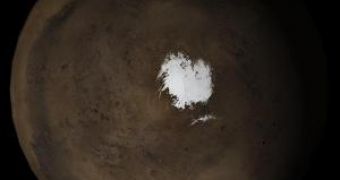Mars, planet Earth's smaller sister is thought to have had (just like our own planet) liquid water in a past warmer state. Early observations of the red planet, revealed channels which the researchers thought to be signs of civilization, only to discover later that they were in fact remnants of proof that Mars had liquid water in the past.
Most of the water now present of Mars is frozen under its dusty surface or at the polar caps, captured in high-resolution images taken by different surveyors scanning the planet, and studying it for a future mission.
Topographic images show that there might be water under large areas of Mars' surface, but the most obvious place for signs of ice is at the poles. As you move from the poles towards the equator, images show evidence of ice having shaped the surface of the planet, much in the same way that glaciers shape the surface of the Earth, while moving under the influence of the gravitational force.
The evidence of ice on Mars' polar caps is obvious, and just like in the case of Earth, it's located between 30 and 60 degrees latitude in both hemispheres, and on Mars' volcanoes there are signs of large glaciers, another striking similarity to our planet.
But the similarities between Earth and Mars stop here. Mars doesn't have a large moon like our own to stabilize its spin rotation; therefore, Mars tilts violently up to 45 degrees, giving birth to raging sand storms and incredibly unstable clime. Studies show that, indeed, Mars was warmer once and had flowing water on its surface, lakes, sees and ever oceans. It still has latitude-dependent clime features, but its axis instability and thin atmosphere triggered the cooling process, in which Mars is still today.
Its latest tilt of the polar caps towards the Sun enabled surveyors in its orbit to take detailed pictures, critical to the study of the planet and of its water cycle. During its tilt towards the Sun, ice from the polar caps evaporate, travels to equatorial regions and middle latitudes and is refrozen on the surface.
The instruments used to study Mars include The Mars Global Surveyor LASER Altimeter, Mars Reconnaissance Orbiter, and many other artificial satellites.

 14 DAY TRIAL //
14 DAY TRIAL //